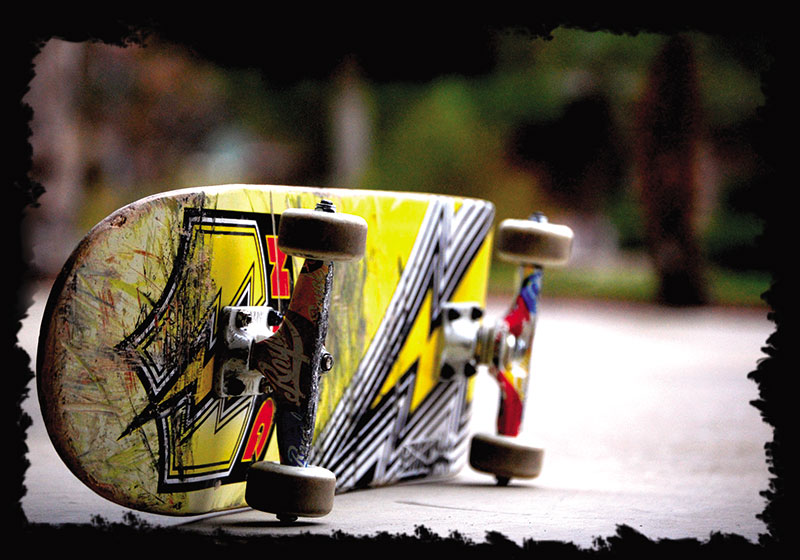SKATE FEVER

The first skateboards appeared in Vietnam over a decade ago, but only recently has it become a popular trend. Walking along the streets of Hanoi and Ho Chi Minh City, many young skaters can be seen practicing and performing tricks. They congregate at places with wide open spaces to skate and practice techniques ranging from basic to advanced. “I only started skateboarding about five months ago, but it has already become an essential part of my daily life. We skaters meet once a week on Saturday or Sunday to share new tricks and learn from each other,” shares Thanh Nam, a skater in Hanoi.
It takes several days to master the balance and technique required to ride a skateboard, and several more weeks to learn some basic tricks. However, technical skills such as the kick flip or crook can take a skater anything from five months up to three years to perfect.
“I found it very difficult to learn how to skate,” Ho Chi Minh City skater Hoang Lam says. “Back then I was wondering how those skaters could skate on the handrails so easily. Now I know that they had fallen hundreds of times before they developed their skills fully.”

Remarkable development
According to Do Ngoc Linh, a senior skater and owner of Hanoi’s LB Skate Shop, skateboarding today is a world away from the scene back in 2001. Over a decade ago, skaters had no choice other than to skate in the city’s parks. Sometimes, they were seen as a problem and prohibited from skating by the citizens living nearby. “The lack of purpose-built skate parks meeting international standards meant limitations in practicing advanced techniques,” Linh shares.
Nowadays, in Hanoi and Ho Chi Minh City, the Vietnamese skateboard community have their own skate parks including Hanoi Creative City and Endee Garden. The community has also diversified and these days it’s common to see girls and international residents amongst the skaters. It is also much easier now to find the special equipment required for skating compared to the past. “The price for a skateboard suitable for beginners ranges from VND900,000 ($41.3) to VND1.5 million ($69),” says Linh. “Professional-level skateboards are much more expensive, with prices ranging from VND3-4 million ($137-183) each.” Aside from the normal sized boards designed with different colors and patterns, mini skateboards are also very popular. As with full size skateboarding, mastering the techniques on these boards takes months of hard practice.
“I am happy to see skateboarding growing in popularity,” says Linh, “but I am still working on developing skateboarding in Vietnam, especially in Hanoi. We need more skateboarding parks, more specialist skate shops and more professional training opportunities for skateboarders. I also plan to start running a skateboarding course for beginners.”
More than a hobby
For committed skateboarders, boarding is far more than just a hobby - it is a whole culture and way of life with particular music, fashion and more. “Skateboarding has clearly changed how I dress and act, helping me to develop my own identity,” Linh explains. Skateboarding also provides health benefits such as burning calories and making the body more flexible. Even though skateboarding has not yet been recognised as an official sport here, the Vietnamese skateboard community has held its own competitions with hundreds of attendants across Vietnam.
Last year, Linh attended Kimberly Diamond Cup in South Africa and came back inspired by what he’d seen from his international competitors. “I was amazed by the foreign skaters’ skills. I might need 15 years of practicing to be able to skate like them,” he shares. Many Vietnamese parents are apprehensive about their children taking up skateboarding, perceiving it to be potentially dangerous and not regarding it as a proper sport. However, Linh says these fears are unfounded: “Skateboarding is not as dangerous as people may think. If youngsters have a purpose-built place to skate rather than skating on the street, their parents would worry less about their safety and the skaters will better avoid injuries.”




What the stars mean:
★ Poor ★ ★ Promising ★★★ Good ★★★★ Very good ★★★★★ Exceptional
Latest News
More News
- TCP Vietnam opens new youth sports yard in Danang (September 22, 2025 | 18:46)
- 'Run For The Heart' to return to Ho Chi Minh City this September (August 29, 2025 | 15:31)
- LION Championship 25 to feature title showdowns in Khanh Hoa (August 15, 2025 | 14:24)
- AFF Women’s Championship 2025: Vietnam defeat Thailand in tense showdown (August 15, 2025 | 14:21)
- Hung Yen win National U11 Football Championship – Nestlé MILO Cup 2025 (August 06, 2025 | 11:34)
- Vietnam win third consecutive ASEAN U-23 title (July 30, 2025 | 07:00)
- Game-changing tech and startups to star at Vietnam Sport Show (July 18, 2025 | 14:56)
- Vietnam women's team secure 6-0 victory over UAE in Asian Cup qualifiers (July 04, 2025 | 15:32)
- Herbalife Vietnam supports VnExpress Marathon Quy Nhon 2025 (June 17, 2025 | 17:38)
- Vietnam lose first Asian Cup qualifiers match against Malaysia (June 12, 2025 | 16:25)

















 Mobile Version
Mobile Version